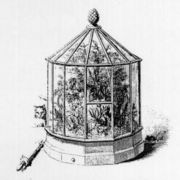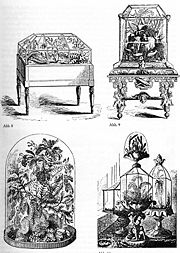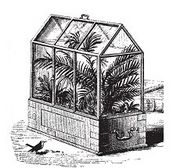
Wardian case
Encyclopedia

Aquarium
An aquarium is a vivarium consisting of at least one transparent side in which water-dwelling plants or animals are kept. Fishkeepers use aquaria to keep fish, invertebrates, amphibians, marine mammals, turtles, and aquatic plants...
), and was invented by Dr. Nathaniel Bagshaw Ward
Nathaniel Bagshaw Ward
Nathaniel Bagshaw Ward was an English doctor who popularized a case for growing and transporting plants which was called the Wardian case....
(1791–1868), of London, in about 1829 after an accidental discovery inspired him.
Discovery
Dr. Ward was a physician with a passion for botany. His personally collected herbariumHerbarium
In botany, a herbarium – sometimes known by the Anglicized term herbar – is a collection of preserved plant specimens. These specimens may be whole plants or plant parts: these will usually be in a dried form, mounted on a sheet, but depending upon the material may also be kept in...
amounted to 25,000 specimens. The fern
Fern
A fern is any one of a group of about 12,000 species of plants belonging to the botanical group known as Pteridophyta. Unlike mosses, they have xylem and phloem . They have stems, leaves, and roots like other vascular plants...
s in his London
London
London is the capital city of :England and the :United Kingdom, the largest metropolitan area in the United Kingdom, and the largest urban zone in the European Union by most measures. Located on the River Thames, London has been a major settlement for two millennia, its history going back to its...
garden in Wellclose Square, however, were being poisoned by London's air pollution
Air pollution
Air pollution is the introduction of chemicals, particulate matter, or biological materials that cause harm or discomfort to humans or other living organisms, or cause damage to the natural environment or built environment, into the atmosphere....
, which consisted heavily of coal smoke and sulphuric acid
Sulfuric acid
Sulfuric acid is a strong mineral acid with the molecular formula . Its historical name is oil of vitriol. Pure sulfuric acid is a highly corrosive, colorless, viscous liquid. The salts of sulfuric acid are called sulfates...
.
Dr. Ward also kept cocoons of moth
Moth
A moth is an insect closely related to the butterfly, both being of the order Lepidoptera. Moths form the majority of this order; there are thought to be 150,000 to 250,000 different species of moth , with thousands of species yet to be described...
s and the like in sealed glass bottles, and in one, he found that a fern spore and a species of grass had germinated and were growing in a bit of soil. Interested but not yet seeing the opportunities, he left the seal intact for about four years, noting that the grass actually bloomed once. After that time however, the seal had rusted, and the plants soon died from the bad air. Understanding the possibilities, he had a carpenter build him a closely fitted glazed wooden case and found that ferns grown in it thrived.
Dr. Ward published his experiment and followed it up with a book in 1842, On the Growth of Plants in Closely Glazed Cases.

Rhizome
In botany and dendrology, a rhizome is a characteristically horizontal stem of a plant that is usually found underground, often sending out roots and shoots from its nodes...
s and roots, as salty air, lack of light, lack of fresh water and lack of sufficient care often destroyed all or almost all plants even in large shipments. With the new Wardian cases, tender young plants could be set on deck to benefit from daylight and the condensed moisture within the case that kept them watered but protected from salt spray. The first test of the glazed cases was made in July 1833, when Dr. Ward shipped two specially constructed glazed cases filled with British ferns and grasses all the way to Sydney, Australia, a voyage of several months that found the protected plants still in good condition upon arrival. Somewhat more interesting plants made the return trip: a number of Australian native species that had never survived the transportation previously. The plants arrived in good shape, after a stormy voyage around Cape Horn
Cape Horn
Cape Horn is the southernmost headland of the Tierra del Fuego archipelago of southern Chile, and is located on the small Hornos Island...
.
One of Dr. Ward's correspondents was William Jackson Hooker
William Jackson Hooker
Sir William Jackson Hooker, FRS was an English systematic botanist and organiser. He held the post of Regius Professor of Botany at Glasgow University, and was the first Director of the Royal Botanic Gardens, Kew. He enjoyed the friendship and support of Sir Joseph Banks for his exploring,...
, later director of the Royal Botanic Gardens, Kew
Royal Botanic Gardens, Kew
The Royal Botanic Gardens, Kew, usually referred to as Kew Gardens, is 121 hectares of gardens and botanical glasshouses between Richmond and Kew in southwest London, England. "The Royal Botanic Gardens, Kew" and the brand name "Kew" are also used as umbrella terms for the institution that runs...
. Hooker's son Joseph Dalton Hooker
Joseph Dalton Hooker
Sir Joseph Dalton Hooker OM, GCSI, CB, MD, FRS was one of the greatest British botanists and explorers of the 19th century. Hooker was a founder of geographical botany, and Charles Darwin's closest friend...
was one of the first plant explorers to use the new Wardian cases, when he shipped live plants back to England from New Zealand in 1841, during the pioneering voyage of HMS Erebus
HMS Erebus (1826)
HMS Erebus was a Hecla-class bomb vessel designed by Sir Henry Peake and constructed by the Royal Navy in Pembroke dockyard, Wales in 1826. The vessel was named after the dark region in Hades of Greek mythology called Erebus...
that circumnavigated Antarctica.

More importantly, the Wardian case unleashed a revolution in the mobility of commercially important plants. In Wardian cases, Robert Fortune
Robert Fortune
Robert Fortune was a Scottish botanist and traveller best known for introducing tea plants from China to India.-Travels and botanical introductions to Europe:Fortune was born in Kelloe, Berwickshire...
shipped to British India 20,000 tea
Tea
Tea is an aromatic beverage prepared by adding cured leaves of the Camellia sinensis plant to hot water. The term also refers to the plant itself. After water, tea is the most widely consumed beverage in the world...
plants smuggled out of Shanghai, China, to begin the tea plantations of Assam
Assam
Assam , also, rarely, Assam Valley and formerly the Assam Province , is a northeastern state of India and is one of the most culturally and geographically distinct regions of the country...
. After germination of imported seeds in the heated glasshouses of Kew, seedlings of the rubber tree
Para rubber tree
Hevea brasiliensis, the Pará rubber tree, often simply called rubber tree, is a tree belonging to the family Euphorbiaceae, and the most economically important member of the genus Hevea...
of Brazil were shipped successfully in Wardian cases to Ceylon (Sri Lanka) and the new British territories in Malaya to start the rubber plantations. Wardian cases have thus been credited for helping break geographic monopolies in the production of important agricultural goods.
Dr. Ward was always active in the Society of Apothecaries of London, of which he became Master in 1854. Until very recently, the Society managed the Chelsea Physic Garden
Chelsea Physic Garden
The Chelsea Physic Garden was established as the Apothecaries’ Garden in London, England in 1673. It is the second oldest botanical garden in Britain, after the University of Oxford Botanic Garden, which was founded in 1621.Its rock garden is the oldest English garden devoted to alpine plants...
, London, the oldest botanical garden in the UK. Ward was a founding member of both the Botanical Society of Edinburgh and the Royal Microscopical Society
Royal Microscopical Society
The Royal Microscopical Society is an international scientific society for the promotion of microscopy. RMS draws members from all over the world and is dedicated to advancing science, developing careers and supporting wider understanding of science and microscopy through its Science and Society...
, a Fellow of the Linnean Society and a Fellow of the Royal Society
Royal Society
The Royal Society of London for Improving Natural Knowledge, known simply as the Royal Society, is a learned society for science, and is possibly the oldest such society in existence. Founded in November 1660, it was granted a Royal Charter by King Charles II as the "Royal Society of London"...
.

